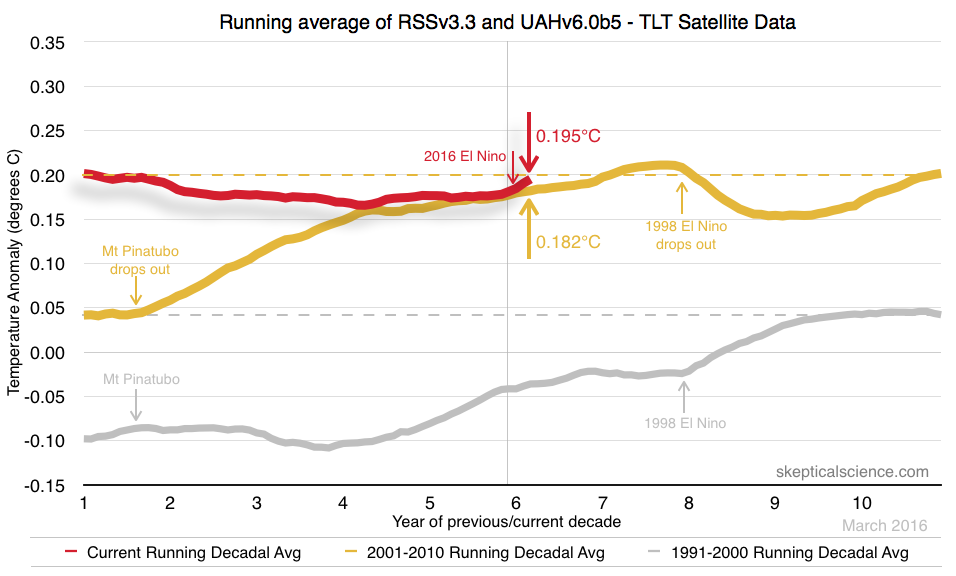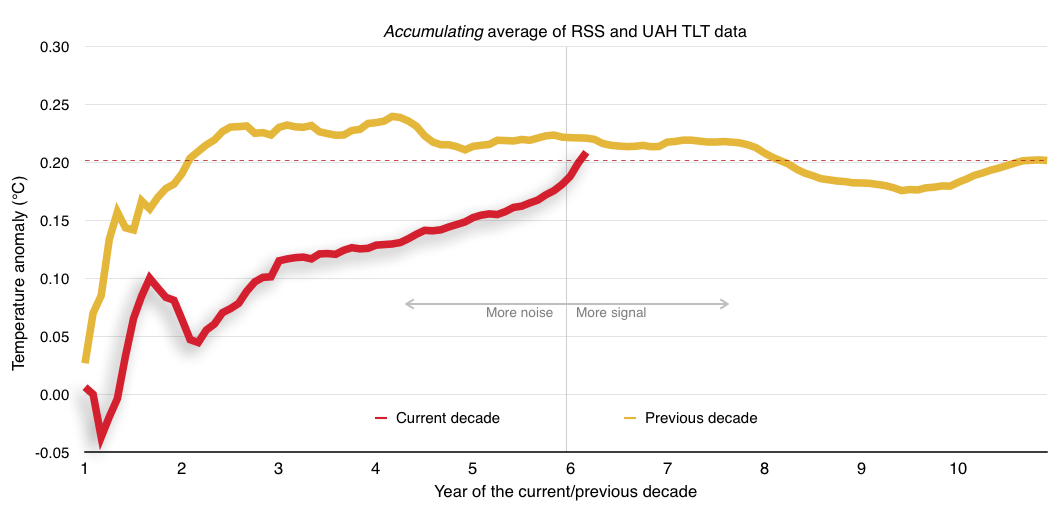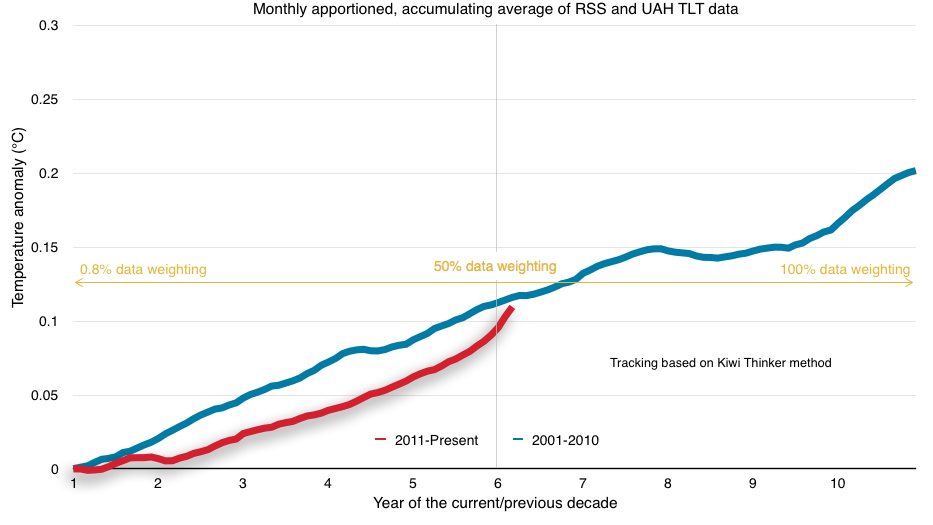
We are now half way into a climate bet made between a number of climate realists and climate contrarians who were commenting on the NoTricksZone blog 5 years ago. This bet originated when I made an off-handed comment at NTZ that I felt contrarians don't have the convictions of their often emphatic beliefs because I'd never found any who would bet on the climate.
Both Dana and myself were active on NTZ at that time, and we worked up a bet through Pierre Gosselin, who owns the NTZ site. Eventually we agreed to a bet stating that, based on an average of UAH and RSS satellite data, the decade of 2011 to 2020 would be warmer than the decade of 2001 to 2010. Realists saying, "Yes, this decade would be warmer." And contrarians saying, "No, this decade would not be warmer."
From there Pierre posted the bet on his website. Eventually, the climate realists raised upward of $10,000 in "realist" bets, and contrarians raised something around half of that for the "contrarian" position.
Half way through, how do things stand? That sort of depends on how you're currently tracking the data.
My preferred method to track the bet is to use a running decadal average and compare where the results would be if the bet had been made ten years previous to this month. Who would win in that case? When you look at it in that context there is no point during the past 5 years when the most recent decade was cooler than the previous decade. It's been close very recently, but still the most recent decade has remained warmer than the previous in the satellite data. (Full size graphic.)

To date, we've only had one major data update coming from the University of Alabama, Huntsville (UAH) group when they moved from their version 5.5 to version 6.0. That had the effect of lowering the UAH trend fairly significantly, and brought it more in line with the Remote Sensing Systems (RSS) v3.3 data.
Last month RSS updated their TTT and TMT data (total troposphere and mid-troposphere, respectively) from version 3.3 to 4.0, which raised those trends significantly. They have yet to update the TLT data (lower troposphere, which we're using) to version 4.0, but when that happens we expect to see more warming from about 2000 forward.
Everything seems to be okay on both sides so far. We agreed that, in spite of differing opinions and perhaps through gritted teeth, each group (UAH and RSS) are good scientists doing their best to get accurate results. We are continuing to operate under the assumption that we will be basing the bet on the most recent TLT data sets published by UAH and RSS.
An aspect that was not considered when the bet was initiated was the timing of climate events on the data. The reason I've included the 1991-2000 data on my chart is to help identify these. We had the Mt. Pinatubo eruption in mid-1991. Pinatubo acted to cool the planet for a couple of years after the eruption, and you can see how the decadal average levels off and then cools slightly. Conversely, in 1998 we saw sharp warming from a super El Nino, and the decadal trend warms quickly and then levels off with the following la Nina.
Climatology works with 30 year time spans as a normal yardstick. One decade can have a lot of influence from the kinds of short term events mentioned above, and 10 years of data is most certainly not going to be statistically significant. None-the-less, I have a great deal of confidence, based on the available scientific research, that the human influence on global warming is strong enough to make it nearly certain that, short of a massive low latitude volcanic event, we will win this bet. Dana did a recent piece in the Guardian showing why betting against global warming is a sure way to lose money.
A blogger called "Kiwi Thinker" has picked up on this bet and decided to create his own graph of how this is progressing. Kiwi Thinker calls his graph an "accumulating average", but I would say he and I have different ideas about what an accumulating average is.
I've created my own accumulating average below and it's nothing like his. My method is to simply take the average of RSS and UAH the first month, then include the average of the two the next month, and then fill the formula down from there. Such a method is accurate but doesn't really reveal very much information merely because the early data is mostly noise. And, as you might expect, the plot levels out as the data accumulates. (Full size image.)

It took me some time to figure out what Kiwi Thinker was doing with his method. He's taking the average of RSS and UAH on the first month and divides it by 120 (months). The next month averages RSS and UAH, divides by 120 and then adds the previous month. (Full size image.)

Kiwi Thinker's method more or less presents the data as a horse race by giving more and more weight to the to the average as it accumulates; in essence, it's double accumulating. It's not an accurate graph because, well, for one, it's saying that the current accumulated average of RSS and UAH is just above 0.1°C, and that's not the case. And the average of UAH+RSS was certainly not 0°C in January 2011. If you average the data for the first 5 years and 3 months (Jan 2011 to present) you get an anomaly of 0.209°C, not 0.109°C.
I'm still struggling to ascribe any real meaning to this chart.
It's really neither here nor there, though, since he will end up with the right answer when the bet finalizes. I just think he's going to be in for a rude surprise over the next 5 years. His method is going to over-emphasize the trend and make it look like we're going to hell in a hand basket. I would also note that on his chart his Y-axis tops out at 0.25°C. He's probably going to have to shift that up to 0.3°C or higher before all is said and done.
I believe the running decadal average method, used in the top graph, offers far more interesting information about decadal warming by making every point along the plot a 10 year average. That makes it easy to compare any two decadal averages by merely choosing a point along the plot and referencing the point directly above or below it.
We're adding a new widget to the SkS right-side sidebar that will be updated on a monthly basis. The next 5 years of this bet are going to be where all the fun is, so it's worth having a little reminder of where things stand.
Here, I'm going to go one step further than just stating that this decade will be warmer than the last. I'm going to predict this decade will end at least 0.1°C warmer than the last, based on UAH+RSS. [This statement is ancillary to the bet.] If I'd made such a statement that ended this month my prediction would be wrong. But looking at how the decadal average rose after the 1998 El Nino, and noting that the following la Nina will only act to flatten the plot after that, I think +0.1°C is pretty safe. You can also note that, after the cooling from Pinatubo dropped out of the average, temperature rose almost 0.15°C in about 5 years. Relative to the decadal trend, that may be somewhat analogous to the extended la Nina and ENSO neutral conditions we've seen since the 1998 El Nino. Note also that 2001 started ~0.15°C warmer than 1991, and 2011 was ~0.15°C warmer than 2001. It's not unreasonable to expect 2020 will end as much as 0.15°C warmer than 2011.
While bets are a fun way to engage people in the issue, it has no direct bearing on what's really important. It's overwhelmingly clear that human activities are responsible for most or all of the warming of the past 50 years. If we continue to emit carbon into the atmosphere at our current rate we risk unconscionable consequences for later generations. We absolutely must shift our energy systems away from fossil fuel sources and replace them with carbon-free energy. We have precious little time to make this fundamental and massive adjustment.
Posted by Rob Honeycutt on Wednesday, 20 April, 2016
 |
The Skeptical Science website by Skeptical Science is licensed under a Creative Commons Attribution 3.0 Unported License. |